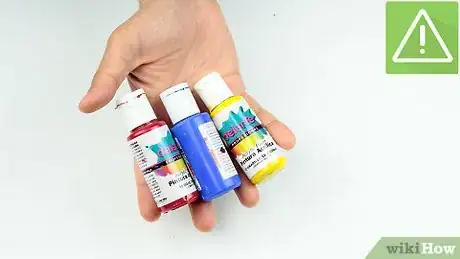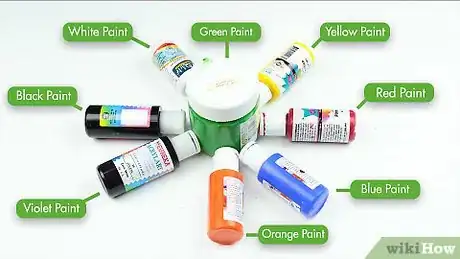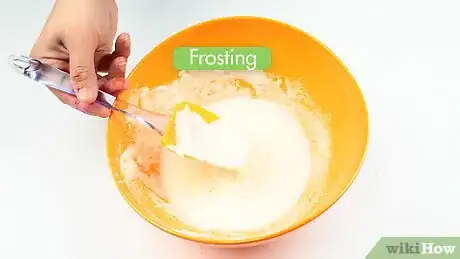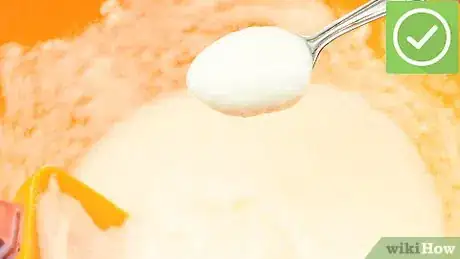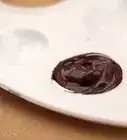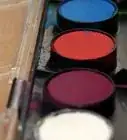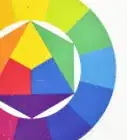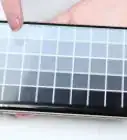wikiHow is a “wiki,” similar to Wikipedia, which means that many of our articles are co-written by multiple authors. To create this article, 24 people, some anonymous, worked to edit and improve it over time.
The wikiHow Video Team also followed the article's instructions and verified that they work.
This article has been viewed 1,229,774 times.
Learn more...
Red is a primary color, so there's nothing you can do to make pure red in any medium. You can, however, make various hues and shades of red by combining pure red with other colors.
Steps
Understanding Color Theory
-
1Know that you cannot make red. Red is a primary color, so you cannot create it by mixing any other colors.
- Primary colors are colors that exist on their own and do not contain traces of any other color. Aside from red, the other primary colors are blue and yellow.
- Even though you cannot make pure red, you can still make other hues of red by mixing pure red with other colors. You can change the value of any red hue in a similar manner.
-
2Change the hue by adding other colors. Mixing pure red with other colors will change the hue. You can combine it with most primary and secondary colors, and each combination will have different results.
- When combining red with the other primary colors, you should only add a small amount of the other color to prevent the red from changing color completely. A little yellow can create an orange-red hue, but too much will create orange. Small amounts of blue can create a violet-red hue, but too much makes violet.
- Mixing red with the secondary color orange will make orange-red, but you should limit the amount of orange to an equal part or less to prevent the hue from becoming more orange than red. Similarly, mixing red with the secondary color violet will make violet-red, but you should limit the violet to an equal part or less.
- You can also mix red with small amounts of the final secondary color, green. Since the two are complements (two colors lying on opposite sides of the color wheel), adding green to red will give the red a hint of brown. Adding too much will change the red to brown or muddy gray, though.
Advertisement -
3Alter the value by adding black or white. If you want to change the value of red without changing the hue, you would need to mix pure red with white or black.
- Adding white will lighten the tint. Too much white creates pink, though.
- Adding black will darken the shade. Too much black can make it difficult to distinguish the original red hue, however.
Mixing Red Paint
-
1Prepare several paints. When painting, you'll likely need several hues of red. You can create most hues by combining pure red with other colors.
- At minimum, you should have red, yellow, blue, orange, violet, green, black, and white paints. Try to choose paints that are as close to the pure hue as possible for each color.
-
2Examine the pure red. Squeeze a small dot of red paint onto your painting palette. Use a paintbrush to transfer a stroke of this paint onto the middle of some scrap paper.
- Take a good look at the red streak. This will be your original sample, and you should compare it to the other reds you mix throughout the rest of the process.
-
3Practice mixing red with other primary colors. Squeeze two more spots of red paint onto the palette. Add a small amount of yellow to one spot and a small amount of blue to the other.
- For either addition, work in vary small amounts and mix them in until no streaks remain. Adding too much of either color can alter the red too drastically and change it into another hue.
- Paint a line of orange-red (made with the yellow) to one side of your original red streak. Paint a line of violet-red (made with blue) to the other side of the original red streak. Compare the different hues.
-
4Mix red with orange and violet. Start with two fresh spots of red paint. Add orange paint to one and violet paint to the other.
- You should be able to mix the two colors in equal parts and still make a red hue, but the red element will be stronger if you use a little less of the secondary color (orange or violet).
- Paint a line of your new orange-red next to the previous orange-red. Paint a line of your new violet-red next to the previous violet-red. Compare these new hues to their counterparts and to the original red sample.
-
5Combine the red with green. Squeeze fresh red onto the palette and mix in a very small amount of green. The red should change into a reddish-brown.
- It's best to start with small dots of green. If desired, you can gradually add more green in small increments to further alter the hue. Adding too much will create brown or gray-brown paint, however.[1]
- Paint a streak of your new color onto the paper, somewhere near the original red sample. Compare the colors.
-
6Change the tint. Add a little white to fresh red paint and a little black to another dab of fresh red. Mix thoroughly.
- Paint a streak of the darkened red near the red-brown sample and compare them; both colors should be dark, but the red-brown sample should have a notable brown element, while the darkened red should not.
- Paint a streak of the lightened red onto the paper, too. Compare the tint with the other samples.
Making Red Frosting
-
1Make the frosting early. Making bright or deep red frosting can be difficult, but the color of the icing will deepen as time passes. It's best to prepare the frosting 24 to 72 hours before you'll need it so the color can set.
- This is especially important if you want pure red frosting made with only red food coloring, but the same trick can also apply to red variations if they aren't as deep in color as you'd like.
-
2Periodically taste the icing. When you need to create dark or bright shades of red, the amount of dye used can cause the icing to become bitter.
- Taste-testing the icing as you work will allow you to monitor the change in flavor and prevent too much bitterness from developing.
- If the icing does become bitter, however, you can usually fix it by adding more flavoring. Stick with clear extracts, and use roughly 1/4 tsp (1.25 ml) per 1 cup (250 ml) of icing.
-
3Add plenty of red dye to the white icing. Place white icing into a non-reactive bowl. Add red food coloring in small increments, mixing well after each addition, and continue until you make a bright red shade.
- It's best to work with gel or paste food coloring specifically formulated for use with icings. Standard liquid coloring isn't concentrated enough; the amount needed to make red frosting would ruin the taste and texture of the icing.
- As a general guideline, you'll need roughly 1/2 tsp (1.25 ml) of red icing color per 1 cup (250 ml) of white icing. If using "No Taste" red icing formulas, you may need 1 tsp (5 ml) of dye per 1 cup (250 ml) of icing.[2]
-
4Try mixing red with brown. If you want to make deep red frosting but only have bright red dye, the best way to achieve the desired color is by adding a little brown.[3]
- Add red food coloring to a dish of white icing, following the same procedure used before. Continue until you achieve a very dark pink or light red.
- Add brown food coloring to the red icing and mix. The amount of brown dye should be roughly one-quarter the amount of red dye, if not a little less. Once mixed, you should have deep red icing with a hint of brown.
- Similarly, you could mix brown cocoa powder into the red icing to deepen the color. Doing so will usually improve the flavor, too.
-
5Experiment with other variations. As with other mediums, you can alter the hue of the frosting by mixing pure red or "red-red" food coloring with other dye colors. Experiment several different combinations, starting with fresh white icing in a clean bowl each time.
- Make burgundy frosting using five parts "rose pink" dye and one part violet dye.
- Mix maroon frosting by combining two parts red-red and one part burgundy dye.
- Create raspberry red by combining red-red and pink.[4]
- Make rust-red by mixing relatively equal amounts of two to three parts red-red, five to eight parts orange, and one part brown.
- Prepare a dark ruby red by adding a small dip of black to prepared red icing.[5]
Mixing Red Polymer Clay
-
1Create warmer reds. If you need a warm tone of red but only have pure red clay, mix the red with a pinch of orange or yellow.
- Use golden yellows and avoid greenish yellows since those may give the red a brown tint. Most orange clays should work well.
- To avoid altering the hue too drastically, only mix a small pinch of the added color into the red sample. Roll, knead, and mash the clays together until no streaks remain. If you need to alter the hue further, add more of the extra color and repeat.
-
2Make cooler reds. If you need a cool tone of red, mix pure red clay with a pinch of blue or violet.
- Warmer blues that contain some traces of violet are better than cooler tones that contain some green. Greenish blues can tint the final hue with brown. Most violet clays should work well, however.
- As with warm red tones, you should mix cool red tones by working the cooler additive into the red clay in small increments.
-
3Deepen the color. You can deepen the color of red clay using pinches of brown or black clay. Regardless of which color you use, you should only add small amounts to avoid changing the red too dramatically.
- Adding brown clay will deepen the color gradually, but it will also change the hue to one with a brown tint.
- Adding black clay will darken the shade of red more drastically, but it will not change the actual hue.
-
4Lighten the red. You can lighten the color of red clay using pinches of white or translucent clay.
- Work small pinches of either clay into the red sample. If the red still isn't light enough, gradually work toward the desired result in small increments.[6]
- Adding white clay will change the value, and adding too much can change the red to pink.
- Adding translucent clay will make the color less bright without altering the value. Up to one-third of the total mixed sample can consist of translucent clay, but using more than that can change the red into a semi-transparent wash of color instead of an opaque hue.
Community Q&A
-
QuestionIf I mix white paint with red food coloring, will it make red paint?
 Community AnswerUse a small amount first then if it works then go ahead. It should because it is a dye.
Community AnswerUse a small amount first then if it works then go ahead. It should because it is a dye. -
QuestionHow do I make clay the color red?
 PhishtacheoCommunity AnswerIt's best if you buy red clay instead of putting in pigment/dye, since if you have white clay and you want to make it red, you'll always end up with a pink color instead of red. But just add as much as you desire if you want to make red.
PhishtacheoCommunity AnswerIt's best if you buy red clay instead of putting in pigment/dye, since if you have white clay and you want to make it red, you'll always end up with a pink color instead of red. But just add as much as you desire if you want to make red. -
QuestionHow can I produce a light grey color using a red color?
 Community AnswerYou can't make gray from red. You can make gray by mixing black and white. If you want to make the gray a little warmer-toned, then you can add a little red.
Community AnswerYou can't make gray from red. You can make gray by mixing black and white. If you want to make the gray a little warmer-toned, then you can add a little red.
Things You'll Need
Mixing Red Paint
- Red paint
- Yellow paint
- Blue paint
- Orange paint
- Violet paint
- Green paint
- Black paint
- White paint
- Paintbrush
- Painting palette
- Scrap practice paper
Making Red Frosting
- White frosting
- Non-reactive bowls
- Spoons
- Red-red icing coloring
- Brown icing coloring (optional)
- Pink icing coloring (optional)
- Black icing coloring (optional)
Mixing Red Polymer Clay
- Red polymer clay
- Yellow or orange polymer clay
- Blue or violet polymer clay
- Black or brown polymer clay
- White or translucent polymer clay
References
- ↑ https://www.youtube.com/watch?v=4wFGR5oezwM
- ↑ http://www.wilton.com/blog/index.php/how-to-make-red-icing-red/
- ↑ http://www.lilaloa.com/2012/01/for-love-of-red-icing.html
- ↑ http://www.wilton.com/decorating/icing/icing-color-chart.cfm
- ↑ http://www.cakecentral.com/tutorial/20151/how-to-color-your-icing
- ↑ http://www.jaedworks.com/clayspot/polyclay-faq/mixing.html
About This Article
To make red shades with paints or food coloring, start by using pure red. You won’t be able to make red from other colors because it’s a primary color that can’t be produced by mixing shades. If you want a cooler red, try mixing red with a small amount of blue to produce a violet-red color. For a warm variation, mix the pure red with yellow to create orange-red. For a burgundy color, mix red with violet. To make a red with strong brown undertones, mix red with orange. If you simply want a lighter shade, stir in white, or for a darker shade, mix with black. If you want to learn how to make red tints and shades with paint, keep reading the article!
